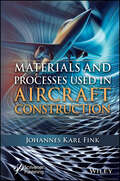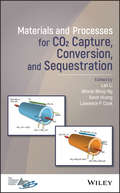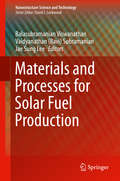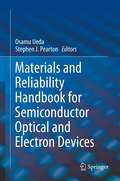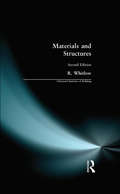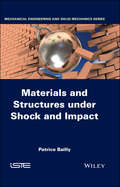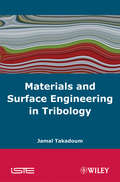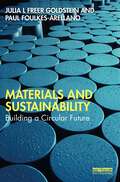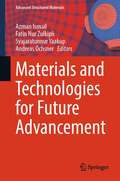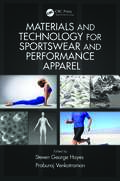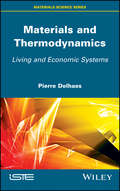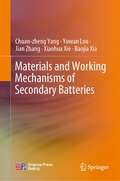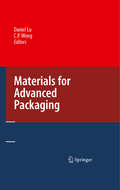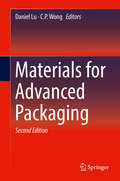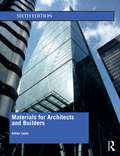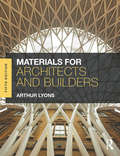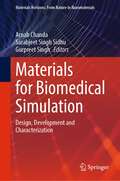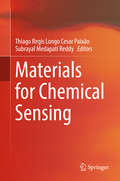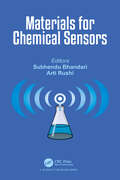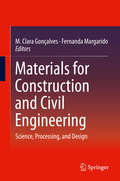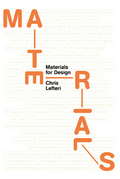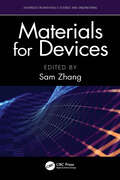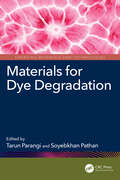- Table View
- List View
Materials and Processes
by Barrie D. DunnThe objective of this book is to assist scientists and engineers select the ideal material or manufacturing process for particular applications; these could cover a wide range of fields, from light-weight structures to electronic hardware. The book will help in problem solving as it also presents more than 100 case studies and failure investigations from the space sector that can, by analogy, be applied to other industries. Difficult-to-find material data is included for reference. The sciences of metallic (primarily) and organic materials presented throughout the book demonstrate how they can be applied as an integral part of spacecraft product assurance schemes, which involve quality, material and processes evaluations, and the selection of mechanical and component parts. In this successor edition, which has been revised and updated, engineering problems associated with critical spacecraft hardware and the space environment are highlighted by over 500 illustrations including micrographs and fractographs. Space hardware captured by astronauts and returned to Earth from long durations in space are examined. Information detailed in the Handbook is applicable to general terrestrial applications including consumer electronics as well as high reliability systems associated with aeronautics, medical equipment and ground transportation. This Handbook is also directed to those involved in maximizing the relia bility of new materials and processes for space technology and space engineering. It will be invaluable to engineers concerned with the construction of advanced structures or mechanical and electronic sub-systems.
Materials and Processes Used in Aircraft Construction
by Johannes Karl FinkMaterials and Processes Used in Aircraft Construction focuses on issues involving the use of plastics in the aerospace industry. A detailed discussion of their various applications is included, along with the innovations presented in the literature over the past decade. A wide range of important topics are discussed in the 13 chapters. Following a brief presentation of the evolution of aircraft design, aircraft design standards, and the simulation of aircraft models, individual chapters focus on: The basic and special materials used in aircraft construction; Lightweight materials for aircraft applications; Polymers used in the aerospace industry; Laminated materials used in the aerospace industry; Wing, helicopter, and balloon designs; Issues concerning the monitoring and management of the health of flight crews and passengers; The benefit of information acquired in real time, leading to an increased understanding of the fracture mechanics of composites, improving confidence in their use, and broadening their applications. Since the cost of inspecting aircraft is approximately one-third of the cost of acquiring and operating composite structures, to compete in the increasingly demanding area of aircraft structures, the cost-effective techniques that need to be developed are discussed. Audience This book will serve the needs of those working in the aerospace industry, both those with only a passing knowledge of the field and specialists who need to increase their knowledge of any particular area.
Materials and Processes for CO2 Capture, Conversion, and Sequestration
by Winnie Wong-Ng Lan Li Kevin Huang Lawrence P. CookAddresses materials, technology, and products that could help solve the global environmental crisis once commercialized This multidisciplinary book encompasses state-of-the-art research on the topics of Carbon Capture and Storage (CCS), and complements existing CCS technique publications with the newest research and reviews. It discusses key challenges involved in the CCS materials design, processing, and modeling and provides in-depth coverage of solvent-based carbon capture, sorbent-based carbon capture, membrane-based carbon capture, novel carbon capture methods, computational modeling, carbon capture materials including metal organic frameworks (MOF), electrochemical capture and conversion, membranes and solvents, and geological sequestration. Materials and Processes for CO2 Capture, Conversion and Sequestration offers chapters on: Carbon Capture in Metal-Organic Frameworks; Metal Organic Frameworks Materials for Post-Combustion CO2 Capture; New Progress of Microporous Metal-Organic Frameworks in CO2 Capture and Separation; In Situ Diffraction Studies of Selected Metal-Organic Framework (MOF) Materials for Guest Capture Applications; Electrochemical CO2 Capture and Conversion; Electrochemical Valorization of Carbon Dioxide in Molten Salts; Microstructural and Structural Characterization of Materials for CO2 Storage using Multi-Scale X-Ray Scattering Methods; Contribution of Density Functional Theory to Microporous Materials for Carbon Capture; and Computational Modeling Study of MnO2 Octahedral Molecular Sieves for Carbon Dioxide Capture Applications. Addresses one of the most pressing concerns of society—that of environmental damage caused by the greenhouse gases emitted as we use fossil fuels Covers cutting-edge capture technology with a focus on materials and technology rather than regulation and cost Highlights the common and novel CCS materials that are of greatest interest to industrial researchers Provides insight into CCS materials design, processing characterization, and computer modeling Materials and Processes for CO2 Capture, Conversion and Sequestration is ideal for materials scientists and engineers, energy scientists and engineers, inorganic chemists, environmental scientists, pollution control scientists, and carbon chemists.
Materials and Processes for Solar Fuel Production
by Balasubramanian Viswanathan Vaidyanathan Ravi Subramanian Jae Sung LeeThis book features different approaches to non-biochemical pathways for solar fuel production. This one-of-a-kind book addresses photovoltaics, photocatalytic water splitting for clean hydrogen production and CO2 conversion to hydrocarbon fuel through in-depth comprehensive contributions from a select blend of established and experienced authors from across the world. The commercial application of solar based systems, with particular emphasis on non-PV based devices have been discussed. This book intends to serve as a primary resource for a multidisciplinary audience including chemists, engineers and scientists providing a one-stop location for all aspects related to solar fuel production. The material is divided into three sections: Solar assisted water splitting to produce hydrogen; Solar assisted CO2 utilization to produce green fuels and Solar assisted electricity generation. The content strikes a balance between theory, material synthesis and application with the central theme being solar fuels.
Materials and Reliability Handbook for Semiconductor Optical and Electron Devices
by Stephen J. Pearton Osamu UedaMaterials and Reliability Handbook for Semiconductor Optical and Electron Devices provides comprehensive coverage of reliability procedures and approaches for electron and photonic devices. These include lasers and high speed electronics used in cell phones, satellites, data transmission systems and displays. Lifetime predictions for compound semiconductor devices are notoriously inaccurate due to the absence of standard protocols. Manufacturers have relied on extrapolation back to room temperature of accelerated testing at elevated temperature. This technique fails for scaled, high current density devices. Device failure is driven by electric field or current mechanisms or low activation energy processes that are masked by other mechanisms at high temperature. The Handbook addresses reliability engineering for III-V devices, including materials and electrical characterization, reliability testing, and electronic characterization. These are used to develop new simulation technologies for device operation and reliability, which allow accurate prediction of reliability as well as the design specifically for improved reliability. The Handbook emphasizes physical mechanisms rather than an electrical definition of reliability. Accelerated aging is useful only if the failure mechanism is known. The Handbook also focuses on voltage and current acceleration stress mechanisms.
Materials and Structures (Chartered Institute of Building)
by R. WhitlowThe second edition of this highly informative book retains much original material covering the principles of structural mechanics and the strength of materials, together with the underlying concepts requisite to the theory of structure and structural design. Some of the material involving lengthy hand-drawing or hand-calculation has been replaced with more up-to-date relevant material and frequent reference is made to computer-aided learning techniques.
Materials and Structures under Shock and Impact (Wiley-iste Ser.)
by Patrice BaillyIn risk studies, engineers often have to consider the consequences of an accident leading to a shock on a construction. This can concern the impact of a ground vehicle or aircraft, or the effects of an explosion on an industrial site. This book presents a didactic approach starting with the theoretical elements of the mechanics of materials and structures, in order to develop their applications in the cases of shocks and impacts. The latter are studied on a local scale at first. They lead to stresses and strains in the form of waves propagating through the material, this movement then extending to the whole of the structure. The first part of the book is devoted to the study of solid dynamics where nonlinear behaviors come into play. The second part covers structural dynamics and the evaluation of the transient response introduced at the global scale of a construction. Practical methods, simplified methods and methods that are in current use by engineers are also proposed throughout the book. The aim of this book is to present theoretical elements regarding solids and structures, as well as modeling tools in order to study the vulnerability of a structure to a short duration action, generally of accidental nature. The book takes the point of view of an engineer seeking for the modeling of the physics at stake to relevantly carry out his study. The book originality is that it gathers elements from various fields of engineering sciences, for the purpose of a practical objective.
Materials and Surface Engineering in Tribology (Wiley-iste Ser.)
by Jamal TakadoumThis title is designed to provide a clear and comprehensive overview of tribology. The book introduces the notion of a surface in tribology where a solid surface is described from topographical, structural, mechanical, and energetic perspectives. It also describes the principal techniques used to characterize and analyze surfaces. The title then discusses what may be called the fundamentals of tribology by introducing and describing the concepts of adhesion, friction, wear, and lubrication. The book focuses on the materials used in tribology, introducing the major classes of materials used, either in their bulk states or as coatings, including both protective layers and other coatings used for decorative purposes. Of especial importance to the tribology community are sections that provide the latest information on Nanotribology, Wear, Lubrication, and Wear-Corrosion: Tribocorrosion and Erosion-Corrosion.
Materials and Sustainability: Building a Circular Future
by Julia L Goldstein Paul Foulkes-ArellanoThis book examines sustainable manufacturing, from the extraction of materials to processing, use, and disposal, and argues that significant changes in all of the above are needed for the world to progress toward a more circular economy.Materials and processing methods are usually chosen with performance as the key metric. Why has our society embraced plastics? Because they work. In most cases, they are lighter, easier to manufacture, and less expensive than the metal, wood, glass, or stone they have replaced. Why do industrial manufacturers use toxic chemicals? Because they are effective, but the unintended consequences may be severe. By learning how various materials are made and what happens when they are recycled, readers will better understand the value of materials and the challenges that manufacturers face when trying to make their facilities and products less toxic and less wasteful. The three chapters in Part I provide essential background about materials in the circular economy, chemicals, and waste. Part II delves into specific materials. It includes chapters on plastics, metals, wood and paper products, glass, and novel materials. Part III covers recycling and manufacturing processes, and Part IV delves into practical considerations, including the effect of regulations, concluding with a chapter that helps readers translate the information presented into action. Interviews with industry experts round out the chapters and offer valuable insights.Materials and Sustainability is a must-read for business professionals who are serious about making their companies as environmentally responsible as possible and for business and engineering students who want to begin their careers with practical knowledge about materials and their impacts.
Materials and Technologies for Future Advancement (Advanced Structured Materials #193)
by Andreas Öchsner Azman Ismail Fatin Nur Zulkipli Syajaratunnur YaakupThis book is a platform to publish new progress in the field of materials and technologies that can offer significant developments with the possibility of changing the future. These emerging developments will change the way we live now at an unprecedented pace across our society. It is important to note that such modern developments are no longer restricted to a single discipline, but are the outcome of a multidisciplinary approach, which combines many different engineering disciplines. This book explores the new technology landscape that will have the direct impact on production-related sectors, individually and in combination with different disciplines. A major driver for this actual research is the efficiency, many times connected with a focus on environmental sustainability.
Materials and Technology for Sportswear and Performance Apparel
by Steven George Hayes Praburaj VenkatramanMaterials and Technology for Sportswear and Performance Apparel takes a close look at the design and development of functional apparel designed for high-performance sportswear. Implementing materials, performance, technology, and design and marketing, the book examines this rapidly emerging textile market and outlines future directions and growing trends. The book begins by explaining how a comfort-driven focus has led the industry to embrace knitted fabric as a popular choice of constructional material. Using examples of leading brands, it outlines the basic terminology, structural details, and essential properties appropriate for performance apparel, especially for sportswear. This book describes the differences between woven and knitted structures, provides an understanding of fabric behavior and the characteristics of a functional garment, and outlines the importance of garment fit and consumer perception of garment comfort in its design and development. The authors present key research outcomes on the design and development of functional apparel designed for high-performance sportswear that explore smart materials, impact-resistant fabrics and pressure sensing. They consider the use of 3-D body scanning and its influence on pattern engineering for apparel product development; highlight the widely used fiber types for sportswear and the importance of fiber blends and their performance, and discuss the relevance of fabric structure and its interaction with the human body. The book also presents research on moisture management and temperature regulation and analyzes the performance and development of smart sportswear intended for monitoring health and performance for a range of end uses.A definitive guide detailing the future of functional clothing and sportswear, this book: Describes how to design and develop functional clothing for sportswear Reflects current research outcomes and industry requirements Clarifies with visual illustration, practical examples, and case studies an understanding of techniques and concepts Explores specifics of garment design such as fit, shape, function, fashion and design Focuses on a commitment to designing ethical and sustainable products
Materials and Thermodynamics
by Pierre DelhaesA thermodynamic system is defined according to its environment and its compliance. This book promotes the classification of materials from generalized thermodynamics outside the equilibrium state and not solely according to their chemical origin. The author goes beyond standard classification of materials and extends it to take into account the living, ecological, economic and financial systems in which they exist: all these systems can be classified according to their deviation from an ideal situation of thermodynamic equilibrium. The concepts of dynamic complexity and hierarchy, emphasizing the crucial role played by cycles and rhythms, then become fundamental. Finally, the limitations of the uniqueness of this description that depend on thermodynamic foundations based on the concepts of energy and entropy are discussed in relation to the cognitive sciences.
Materials and Working Mechanisms of Secondary Batteries
by Jian Zhang Chuan-zheng Yang Yuwan Lou Xiaohua Xie Baojia XiaThis book provides a description of material characterization and mechanisms of secondary batteries during discharge, cycle, and storage process. It also proposes a new intercalation/de-intercalation theory and presents the mechanism of ionic conduction. In addition, through the comparative study of variation laws of battery performance and of fine structure and microstructure parameters, the mechanism of cycle and storage processes and battery performance decay are investigated. Given its scope, the book appeals to a broad readership, particularly professionals at universities and scientific research institutes.
Materials for Advanced Packaging
by C. P. Wong Daniel LuSignificant progress has been made in advanced packaging in recent years. Several new packaging techniques have been developed and new packaging materials have been introduced. This book provides a comprehensive overview of the recent developments in this industry, particularly in the areas of microelectronics, optoelectronics, digital health, and bio-medical applications. The book discusses established techniques, as well as emerging technologies, in order to provide readers with the most up-to-date developments in advanced packaging.
Materials for Advanced Packaging
by C. P. Wong Daniel LuSignificant progress has been made in advanced packaging in recent years. Several new packaging techniques have been developed and new packaging materials have been introduced. This book provides a comprehensive overview of the recent developments in this industry, particularly in the areas of microelectronics, optoelectronics, digital health, and bio-medical applications. The book discusses established techniques, as well as emerging technologies, in order to provide readers with the most up-to-date developments in advanced packaging.
Materials for Architects and Builders
by Arthur LyonsMaterials for Architects and Builders provides a clear and concise introduction to the broad range of materials used within the construction industry and covers the essential details of their manufacture, key physical properties, specification and uses. Understanding the basics of materials is a crucial part of undergraduate and diploma construction or architecture-related courses, and this established textbook helps the reader to do just that with the help of colour photographs and clear diagrams throughout. This new 6th edition has been completely revised and updated to include the latest developments in materials research, new images, appropriate technologies and relevant legislation. The ecological effects of building construction and lifetime use remain an important focus, and this new edition includes a wide range of energy saving building components.
Materials for Architects and Builders: An Introduction
by Arthur LyonsMaterials for Architects and Builders provides a clear and concise introduction to the broad range of materials used within the construction industry and covers the essential details of their manufacture, key physical properties, specification and uses. Understanding the basics of materials is a crucial part of undergraduate and diploma construction or architecture-related courses, and this established textbook helps the reader to do just that with the help of colour photographs and clear diagrams throughout. This new edition has been completely revised and updated to include the latest developments in materials research, new images, appropriate technologies and relevant legislation. The ecological effects of building construction and lifetime use remain an important focus, and this new edition includes a wide range of energy saving building components.
Materials for Biomedical Simulation: Design, Development and Characterization (Materials Horizons: From Nature to Nanomaterials)
by Gurpreet Singh Sarabjeet Singh Sidhu Arnab ChandaThe book provides an overview of prospective material simulants for hard tissues, such as knee joints, hip joint, and bones, and soft tissues, such as skin, muscles, and functional organs. These materials can repair, replace the functionality, or mimic the mechanical, structural, and biological properties of the parent tissue. This book discusses hard and soft human tissue simulating biomaterials under a single umbrella, covering a broad area of design and development of biomaterials, implants, and multi-functional materials along with their characterization. The progress in emerging biomaterials has increased manifold in the recent decades with the unprecedented focus on healthcare technologies. This book is dedicated to ground-breaking research in biomaterials and highlights the current trends and future roadmap of different materials for simulation of hard and soft tissues. Authored by prominent researchers around the globe, the chapters of this book emphasize recent advances in biomedical material simulation. This book brings together novel contributions to different aspects of hard and soft human tissue-based biomaterials, including recent advances and emerging developments in designing and developing simulants for tissue replacement alternatives. This book is anticipated to serve as a key reference textbook for research in tissue engineering & biomedical engineering, biomaterials, biomechanics, and implant & medical device development with contributed chapters solicited in the areas of soft materials, such as elastomers, hydrogels, etc., for various applications; auxetic metamaterials; additive manufacturing of bio-implants; artificial tissues and organs; development of biomimetic materials; medical implants and biomedical device design; bioinspired and bio-tribological materials; advances in materials science for biomaterial applications; biomechanical characterization of hard and soft human tissues; bioprinting and nano-biomaterials.
Materials for Chemical Sensing
by Thiago Regis Longo Cesar Paixão Subrayal Medapati ReddyThis book covers new materials used as analytical devices for increasing the interactions between the development of new analytical devices and materials science. The authors describe how different types of materials such as polymers, self-assembled layers, phthalocyanines, and nanomaterials can further enhance sensitivity and promote selectivity between analytes for different applications. They explain how continuing research and discussion into materials science for chemical sensing is stimulating the search for different strategies and technologies that extract information for these chemical sensors in order to obtain a chemical fingerprint of samples.
Materials for Chemical Sensors
by Subhendu Bhandari Arti RushiApplication as well as detection of different chemicals plays an important role in the progress of modern science and technology. The beauty of various characteristics of materials and the inherent logic behind their working mechanisms can be wisely utilized for sensing different chemicals. The mechanisms as well as performances of different materials viz. carbon nanotube, graphene, metal oxides, biomaterials, luminescent metal-organic frameworks, hydrogels, textiles, quantum dots, ligands, crown ethers etc. for identification of different chemicals has been discussed here. This book would be a valuable reference to select suitable materials for possible use in chemical sensors.
Materials for Construction and Civil Engineering
by M. Clara Gonçalves Fernanda MargaridoThis expansive volume presents the essential topics related to construction materials composition and their practical application in structures and civil installations. The book's diverse slate of expert authors assemble invaluable case examples and performance data on the most important groups of materials used in construction, highlighting aspects such as nomenclature, the properties, the manufacturing processes, the selection criteria, the products/applications, the life cycle and recyclability, and the normalization. Civil Engineering Materials: Science, Processing, and Design is ideal for practicing architects; civil, construction, and structural engineers, and serves as a comprehensive reference for students of these disciplines. This book also: · Provides a substantial and detailed overview of traditional materials used in structures and civil infrastructure · Discusses properties of natural and synthetic materials in construction and materials' manufacturing processes · Addresses topics important to professionals working with structural materials, such as corrosion, nanomaterials, materials life cycle, not often covered outside of journal literature · Diverse author team presents expect perspective from civil engineering, construction, and architecture · Features a detailed glossary of terms and over 400 illustrations
Materials for Design
by Chris LefteriOver the last ten years there has been a huge growth in the area of materials for design, but most books on this subject deal with advanced, semi-formed materials (that is, materials sold as sheet, rod, tube, etc.). This book provides much-needed information on the raw materials, and the low-down on how these can be used. Organized into three sections embracing grown, oil-based and mined materials, each entry includes information on key features, typical applications, production processes and sustainability issues. This fact-packed book will allow professional designers and students from a range of disciplines to understand in simple, exciting, visual terms the different qualities and features of materials.
Materials for Design: Materials For Inspirational Design (Materials For Inspirational Design Ser.)
by Chris LefteriOver the last ten years there has been a huge growth in the area of materials for design, but most books on this subject deal with advanced, semi-formed materials (that is, materials sold as sheet, rod, tube, etc.). This book provides much-needed information on the raw materials, and the low-down on how these can be used. Organized into three sections embracing grown, oil-based and mined materials, each entry includes information on key features, typical applications, production processes and sustainability issues. This fact-packed book will allow professional designers and students from a range of disciplines to understand in simple, exciting, visual terms the different qualities and features of materials.
Materials for Devices (Advances in Materials Science and Engineering)
by Sam ZhangFrom everyday applications to the rise of automation, devices have become ubiquitous. Specific materials are employed in specific devices because of their particular properties, including electrical, thermal, magnetic, mechanical, ferroelectric, and piezoelectric. Materials for Devices discusses materials selection for optimal application and highlights current materials developments in gas sensors, optical devices, mechanoelectrical devices, and medical and biological devices. Explains how to select the right material for the right device Includes 2D materials, thin films, smart piezoelectric films, and more Presents details on organic solar cells Describes thin films in sensors, actuators, and LEDs Covers thin films and elastic polymers in biomedical devices Discusses growth and characterization of intrinsic magnetic topological insulators This work is aimed at researchers, technologists, and advanced students in materials and electrical engineering and related fields who are interested in developing sensors or devices.
Materials for Dye Degradation (Emerging Materials and Technologies)
by Tarun Parangi Soyebkhan PathanIncreased use of dyes compromises the visual quality of water sources and enhances the biochemical and chemical oxygen demand that promote toxicity, mutagenicity, and carcinogenicity of the environments. This book presents a broad-spectrum content of the functionalized materials and well-established methods, and a commercial perspective of various investigations conducted so far on dye degradation as an environmental cleaning application. It confines the emerging areas of advanced materials and efficient methods for the environmental remediation field as accommodating concepts. Describes fundamental as well as advancements in the field related to dye degradation and dye removal Discusses growth in the strategies to mitigate dye-related environmental issues through photocatalysis, electrocatalysis, and nanotechnology Covers photocatalysis micellar catalysis, electrocatalysis ion exchange materials, and nanomaterials Deals with various the synthetic approaches and future perspectives for development of the advanced materials Focuses on pertinent green and sustainability aspects related to the environment. This book is aimed at researchers and graduate students in environmental science, nanoscience, dyes, and chemistry.

